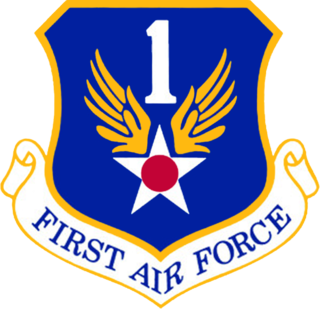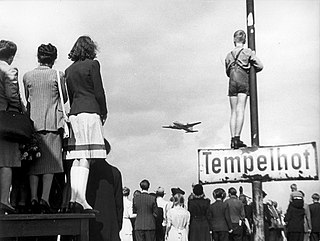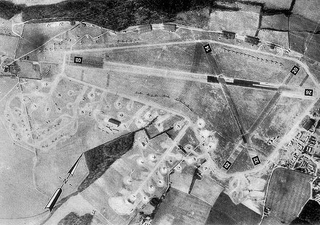| Massachusetts World War II Army Airfields | |
|---|---|
| Part of World War II | |
| Type | Army Airfields |
| Site history | |
| Built | 1940-1944 |
| In use | 1940-present |
During World War II, the United States Army Air Forces (USAAF) established numerous airfields in Massachusetts for training pilots and aircrews of USAAF fighters and bombers.

World War II, also known as the Second World War, was a global war that lasted from 1939 to 1945. The vast majority of the world's countries—including all the great powers—eventually formed two opposing military alliances: the Allies and the Axis. A state of total war emerged, directly involving more than 100 million people from over 30 countries. The major participants threw their entire economic, industrial, and scientific capabilities behind the war effort, blurring the distinction between civilian and military resources. World War II was the deadliest conflict in human history, marked by 50 to 85 million fatalities, most of whom were civilians in the Soviet Union and China. It included massacres, the genocide of the Holocaust, strategic bombing, premeditated death from starvation and disease, and the only use of nuclear weapons in war.

The United States Army Air Forces, informally known as the Air Force,or United States Army Air Force, was the aerial warfare service component of the United States Army during and immediately after World War II (1939/41–1945), successor to the previous United States Army Air Corps and the direct predecessor of the United States Air Force of today, one of the five uniformed military services. The AAF was a component of the United States Army, which in 1942 was divided functionally by executive order into three autonomous forces: the Army Ground Forces, the Services of Supply, and the Army Air Forces. Each of these forces had a commanding general who reported directly to the Army Chief of Staff.

Massachusetts, officially the Commonwealth of Massachusetts, is the most populous state in the New England region of the northeastern United States. It borders on the Atlantic Ocean to the east, the states of Connecticut and Rhode Island to the south, New Hampshire and Vermont to the north, and New York to the west. The state is named after the Massachusett tribe, which once inhabited the east side of the area, and is one of the original thirteen states. The capital of Massachusetts is Boston, which is also the most populous city in New England. Over 80% of Massachusetts's population lives in the Greater Boston metropolitan area, a region influential upon American history, academia, and industry. Originally dependent on agriculture, fishing and trade, Massachusetts was transformed into a manufacturing center during the Industrial Revolution. During the 20th century, Massachusetts's economy shifted from manufacturing to services. Modern Massachusetts is a global leader in biotechnology, engineering, higher education, finance, and maritime trade.
Contents
Most of these airfields were under the command of First Air Force or the Army Air Forces Training Command (AAFTC) (A predecessor of the current-day United States Air Force Air Education and Training Command). However the other USAAF support commands (Air Technical Service Command (ATSC); Air Transport Command (ATC) or Troop Carrier Command) commanded a significant number of airfields in a support roles.

The First Air Force is a numbered air force of the United States Air Force Air Combat Command (ACC). It is headquartered at Tyndall Air Force Base, Florida. Its primary mission is the air defense of the Contiguous United States (CONUS), United States Virgin Islands and Puerto Rico.

Air Training Command (ATC) is a former United States Air Force (USAF) Major Command designation. It was headquartered at Randolph Air Force Base, Texas, but was initially formed at Barksdale Air Force Base, Louisiana. It was re-designated as Air Education and Training Command (AETC) following a merger with Air University (AU) on 1 July 1993.

The United States Air Force (USAF) is the aerial and space warfare service branch of the United States Armed Forces. It is one of the five branches of the United States Armed Forces, and one of the seven American uniformed services. Initially formed as a part of the United States Army on 1 August 1907, the USAF was established as a separate branch of the U.S. Armed Forces on 18 September 1947 with the passing of the National Security Act of 1947. It is the youngest branch of the U.S. Armed Forces, and the fourth in order of precedence. The USAF is the largest and most technologically advanced air force in the world. The Air Force articulates its core missions as air and space superiority, global integrated intelligence, surveillance, and reconnaissance, rapid global mobility, global strike, and command and control.
It is still possible to find remnants of these wartime airfields. Many were converted into municipal airports, some were returned to agriculture and several were retained as United States Air Force installations and were front-line bases during the Cold War. Hundreds of the temporary buildings that were used survive today, and are being used for other purposes.

The Cold War was a period of geopolitical tension between the Soviet Union with its satellite states, and the United States with its allies after World War II. A common historiography of the conflict begins between 1946, the year U.S. diplomat George F. Kennan's "Long Telegram" from Moscow cemented a U.S. foreign policy of containment of Soviet expansionism threatening strategically vital regions, and the Truman Doctrine of 1947, and ending between the Revolutions of 1989, which ended communism in Eastern Europe, and the 1991 collapse of the USSR, when nations of the Soviet Union abolished communism and restored their independence. The term "cold" is used because there was no large-scale fighting directly between the two sides, but they each supported major regional conflicts known as proxy wars. The conflict split the temporary wartime alliance against Nazi Germany and its allies, leaving the USSR and the US as two superpowers with profound economic and political differences.





















